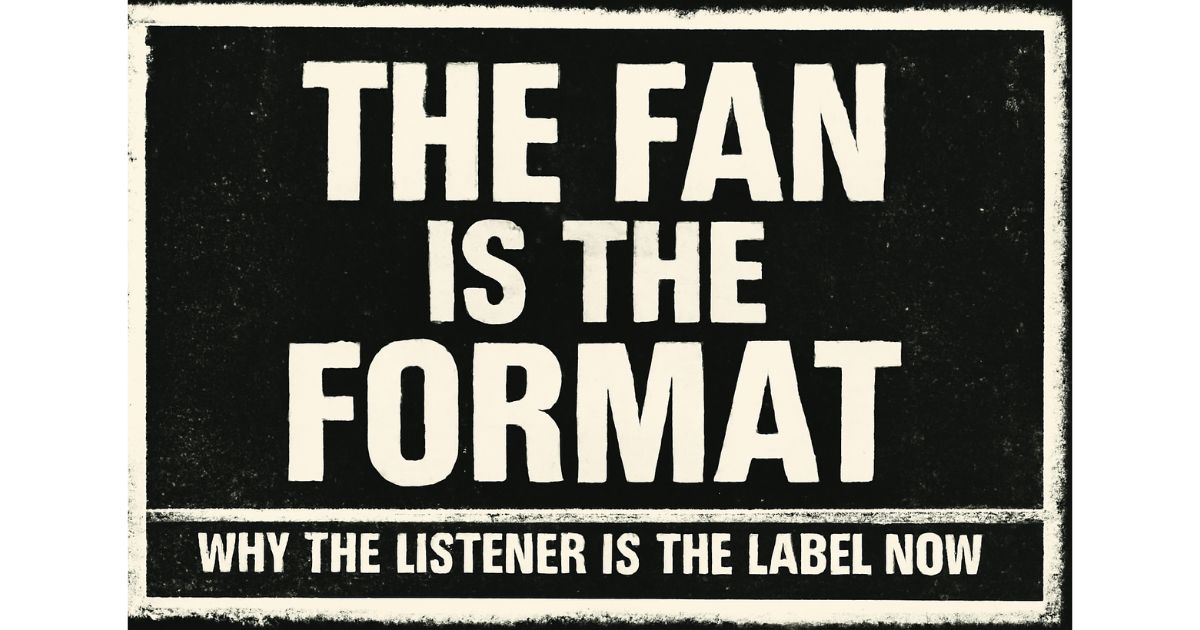Physical Address
5106 Whitman Way, Carlsbad, CA 92008
Physical Address
5106 Whitman Way, Carlsbad, CA 92008

Once upon a time, a record label decided who made it big and who stayed underground. Then came the era of streaming platforms, where listeners could choose what they consumed. And now, in 2025, we’re witnessing something even more groundbreaking: the fan as the format — discovery that happens beyond the algorithm and outside old gatekeeping rules.
Gone are the days when the industry alone decided what made a hit. Today, fans have become the ultimate curators, the critics, and even the creators themselves. They don’t just consume music — they are its most powerful force.
The listener no longer just listens; they create the narrative, curate the playlist, and define the genre. In this article, we’ll dive into how the music industry flipped — with fans now holding the power.
The digital age has empowered listeners in ways once unimaginable. With streaming, fans build their own ecosystems of taste and discover new music daily. More importantly, they control how that music circulates.
Instead of waiting for radio to decide what’s popular, fans create playlists, post takes, and decide what trends. TikTok, Instagram, and Reddit amplify those choices into millions of impressions; the mechanics behind what gets skipped or saved show up in our Skip Button: Data & Insights report.
The role of the critic has changed, too. They’re no longer the sole arbiters of taste. Niche forums and Discords now set the agenda — and a lot of those voices started as DIY writers. If you want in on that conversation, here’s how to become a music journalist in the streaming era, and a directory of the best music blogs shaping taste right now.
If labels used to be the gatekeepers, playlists are the new arbiters. Fans now craft public, identity-forward lists — mini zines made of songs — organized by mood, moment, or micro‑scene. For mood-led programming at home, check our field notes on Parenting by Playlist. And when your vibe is task-based, the slow-focus stacks in music to listen to while reading punch way above their weight.
Great curators don’t just soundtrack themselves; they soundtrack other people’s days. These super‑curators can push new artists, resurrect forgotten tracks, and surface genres that might otherwise remain underground — especially when lists are built for sharing on Instagram Stories and similar social canvases.
Today, criticism happens in YouTube comments, Twitter threads, and TikTok reviews — fast, public, and iterative. Fans, not just publications, steer the conversation. That feedback loop is powered by data and taste graphs we explored in Music Discovery & AI Analytics.
Criticism is also more personal. People sort by identity and use-case rather than genre, echoing the psychographics in Types of Music Listeners. And when a song crosses that familiarity threshold, it lands in the cultural canon — the staples you’ll find in songs that everyone knows.
Artists no longer need traditional channels to be heard. The fan‑as‑creator model has supercharged DIY output across SoundCloud, Bandcamp, and YouTube — with distribution handled by free music distributors for independent artists and submissions guided by a practical music submission playbook.
Decentralized ecosystems are rising too. Onchain‑adjacent platforms and fan communities are experimenting with royalties, ownership, and discovery — see our primer on Audius and music on the blockchain for where that’s headed.
This isn’t top‑down anymore. It’s bottom‑up — and geography matters. City‑level listening can predict global breakouts months in advance, as we charted in Trigger Cities and the follow‑up map How Manila, Lisbon, and Gqeberha Helped Launch Global Music.
Teens and micro‑scenes are often the first‑movers here. For a snapshot of how a youth audience can rewrite the script outside major‑label cycles, see K‑indie: What Korean Teens Really Listen To.
With fans steering curation, we’re trending toward a more democratic industry — one where artists can thrive without contorting to a monolithic mainstream. The tools now exist for anyone to build taste, publish signals, and lift scenes. If you’re building your own ecosystem, keep an eye on podcast trends in new music, and the utilities that help creators read their audience, like Spotify stats sites.
The curator is no longer just an editor or executive. It’s everyone with a playlist, a post, or a recommendation. Fans are creators, critics, and curators — blending their tastes into the soundscape of tomorrow.

The first time Nicholas went to a live gig, 31 years ago, it turned out to be an Iron Maiden secret gig and he became hooked on the music scene. He was one of the founding writers for Astro Zombie a heavy metal and new world techno-inspired zine and his interview with Rob Caggiano of Anthrax brought in over 300,000 readers. He’s based out of Southeast Asia now, but his love of music is as strong and diverse as ever.